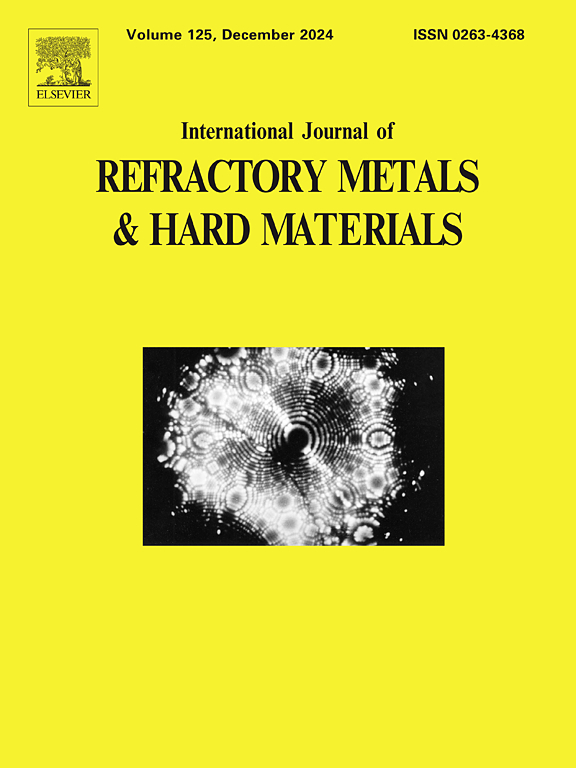利用约束效应改善激光加工硬质合金力学性能和摩擦学性能的研究
IF 4.6
2区 材料科学
Q2 MATERIALS SCIENCE, MULTIDISCIPLINARY
International Journal of Refractory Metals & Hard Materials
Pub Date : 2025-06-30
DOI:10.1016/j.ijrmhm.2025.107305
引用次数: 0
摘要
激光加工已广泛应用于微织构的制备;然而,高能激光烧蚀导致了重铸层的形成。由此产生的热影响区(HAZ)进一步促进了工件表面缺陷的发展,如孔隙和微裂纹。这些缺陷严重阻碍了微织构元件的实际应用。受约束效应的启发,本研究探讨了战略性分布的微织构如何局部定位激光热影响区并减轻高能激光烧蚀引起的缺陷。首先分析了硬质合金激光加工过程中缺陷的形成机理。随后,通过优化微织构排列,利用约束效应来减轻激光诱导缺陷的有害影响。结果表明,激光直接写入导致表面缺陷的形成,包括重铸层,孔隙和微裂纹,这对材料的机械性能产生了负面影响。然而,约束效应抑制了裂纹扩展,提高了抗弯强度,提高了5.3%。摩擦试验表明,低密度微织构作为碎屑储集层和摩擦改良剂,有效降低了摩擦系数。相比之下,高密度微纹理由于过早失效而降低了性能,从而使其减少摩擦的能力失效。本文章由计算机程序翻译,如有差异,请以英文原文为准。
Study on the improvement of laser-processed cemented carbide mechanical properties and tribological performance through confinement effect
Laser processing has been widely employed for fabricating micro-textures; however, high-energy laser ablation has led to the formation of a recast layer. The resulting heat-affected zone (HAZ) further contributes to the development of defects, such as pores and microcracks, on the surfaces of the workpieces. These imperfections have significantly impeded the practical application of micro-textured components. Inspired by the confinement effect, this study has investigated how strategically distributed micro-textures can localize the thermal influence zone of the laser and mitigate defects caused by high-energy laser ablation. Initially, the defect formation mechanism during the laser processing of cemented carbide has been analyzed. Subsequently, the confinement effect was harnessed through optimized micro-texture arrangements to mitigate the detrimental effects of laser-induced defects. The results indicated that laser direct writing led to the formation of surface defects—including recast layers, pores, and microcracks—which negatively impacted the material's mechanical properties. However, the confinement effect was found to suppress crack propagation and enhance flexural strength, resulting in a 5.3 % improvement. Friction tests demonstrated that low-density micro-textures effectively reduced the friction coefficient by acting as reservoirs for debris and friction modifiers. In contrast, high-density micro-textures compromised performance due to premature failure, thereby nullifying their friction-reduction capability.
求助全文
通过发布文献求助,成功后即可免费获取论文全文。
去求助
来源期刊
CiteScore
7.00
自引率
13.90%
发文量
236
审稿时长
35 days
期刊介绍:
The International Journal of Refractory Metals and Hard Materials (IJRMHM) publishes original research articles concerned with all aspects of refractory metals and hard materials. Refractory metals are defined as metals with melting points higher than 1800 °C. These are tungsten, molybdenum, chromium, tantalum, niobium, hafnium, and rhenium, as well as many compounds and alloys based thereupon. Hard materials that are included in the scope of this journal are defined as materials with hardness values higher than 1000 kg/mm2, primarily intended for applications as manufacturing tools or wear resistant components in mechanical systems. Thus they encompass carbides, nitrides and borides of metals, and related compounds. A special focus of this journal is put on the family of hardmetals, which is also known as cemented tungsten carbide, and cermets which are based on titanium carbide and carbonitrides with or without a metal binder. Ceramics and superhard materials including diamond and cubic boron nitride may also be accepted provided the subject material is presented as hard materials as defined above.

 求助内容:
求助内容: 应助结果提醒方式:
应助结果提醒方式:


